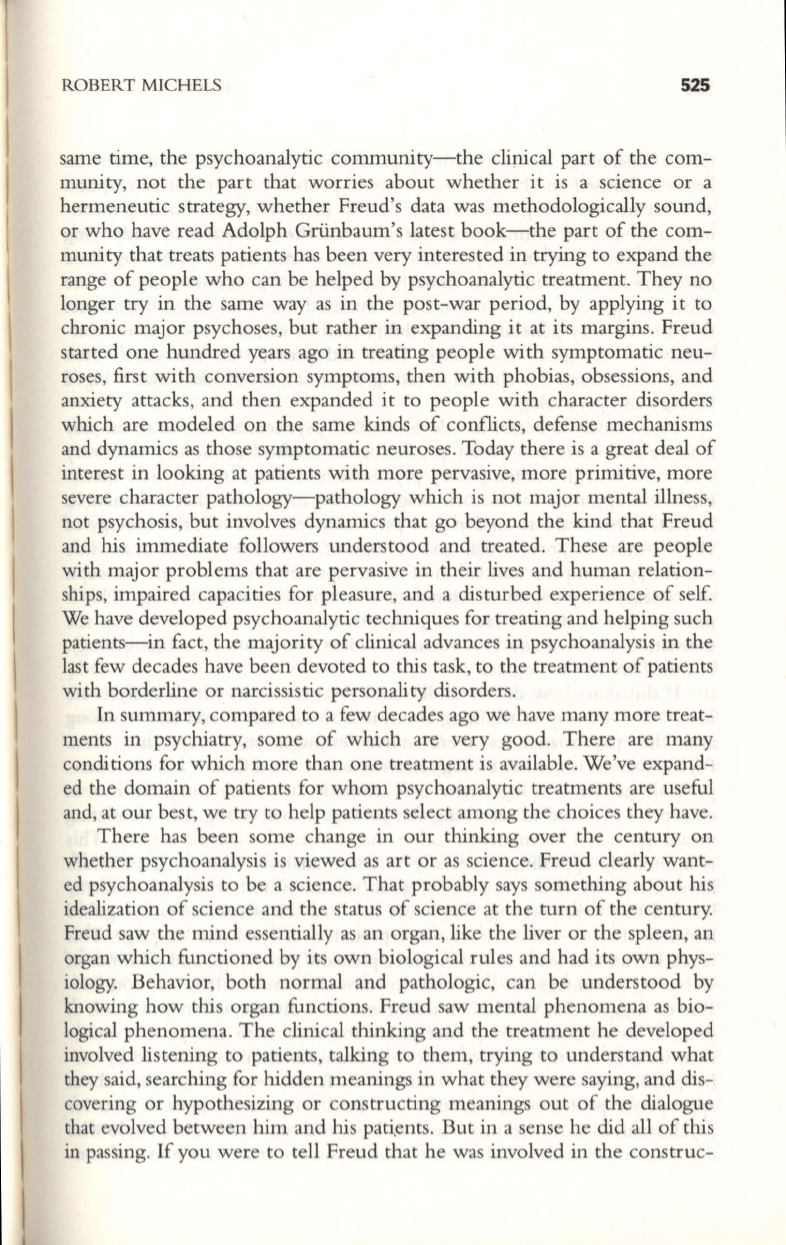
ROBERT MICHELS
525
same time, the psychoanalytic communi ty-the clinical part of the com–
munity, not the part that worries about whether it is a science or a
hermeneutic strategy, whether Freud's data was methodologically sound,
or who have read Adolph Griinbaum's latest book-the part of the com–
munity that treats patients has been very interested in trying to expand the
range of people who can be helped by psychoanalytic treatment. They no
longer try in the same way as in the post-war period, by applying it to
chronic major psychoses, but rather in expanding it at its margins. Freud
started one hundred years ago in treating people with symptomatic neu–
roses, first with conversion symptoms, then with phobias, obsessions, and
anxiety attacks, and then expanded it to people with character disorders
which are modeled on the same kinds of conflicts, defense mechanisms
and dynamics as those symptomatic neuroses. Today there is a great deal of
interest in looking at patients with more pervasive, more primitive, more
severe character pathology-pathology which is not major mental illness,
not psychosis, but involves dynamics that go beyond the kind that Freud
and his immediate followers understood and treated. These are people
with major problems that are pervasive in their lives and human relation–
ships, impaired capacities for pleasure, and a disturbed experience of self.
We have developed psychoanalytic techniques for treating and helping such
patients-in fact, the majority of clinical advances in psychoanalysis in the
last few decades have been devoted to this task, to the treatment of patients
with borderline or narcissistic personality disorders.
In
summary, compared to a few decades ago we have many more treat–
ments in psychiatry, some of which are very good. There are many
conditions for which more than one treatment is available. We've expand–
ed the domain of patients for whom psychoanalytic treatments are useful
and, at our best, we try to help patients select among the choices they have.
There has been some change in our thinking over the century on
whether psychoanalysis is viewed as art or as science. Freud clearly want–
ed psychoanalysis to be a science. That probably says something about his
idealization of science and the status of science at the turn of the century.
Freud saw the mind essentially as an organ, like the liver or the spleen, an
organ which functioned by its own biological rules and had its own phys–
iology. Behavior, both normal and pathologic, can be understood by
knowing how this organ functions. Freud saw mental phenomena as bio–
logical phenomena. The clinical thinking and the treatment he developed
involved listening to patients, talking to them, trying to understand what
they said, searching for hidden meanings in what they were saying, and dis–
covering or hypothesizing or constructing meanings out of the dialogue
that evolved between him and his pati,ents. But in a sense he did all of this
in passing. If you were to tell Freud that he was involved in the construc-


